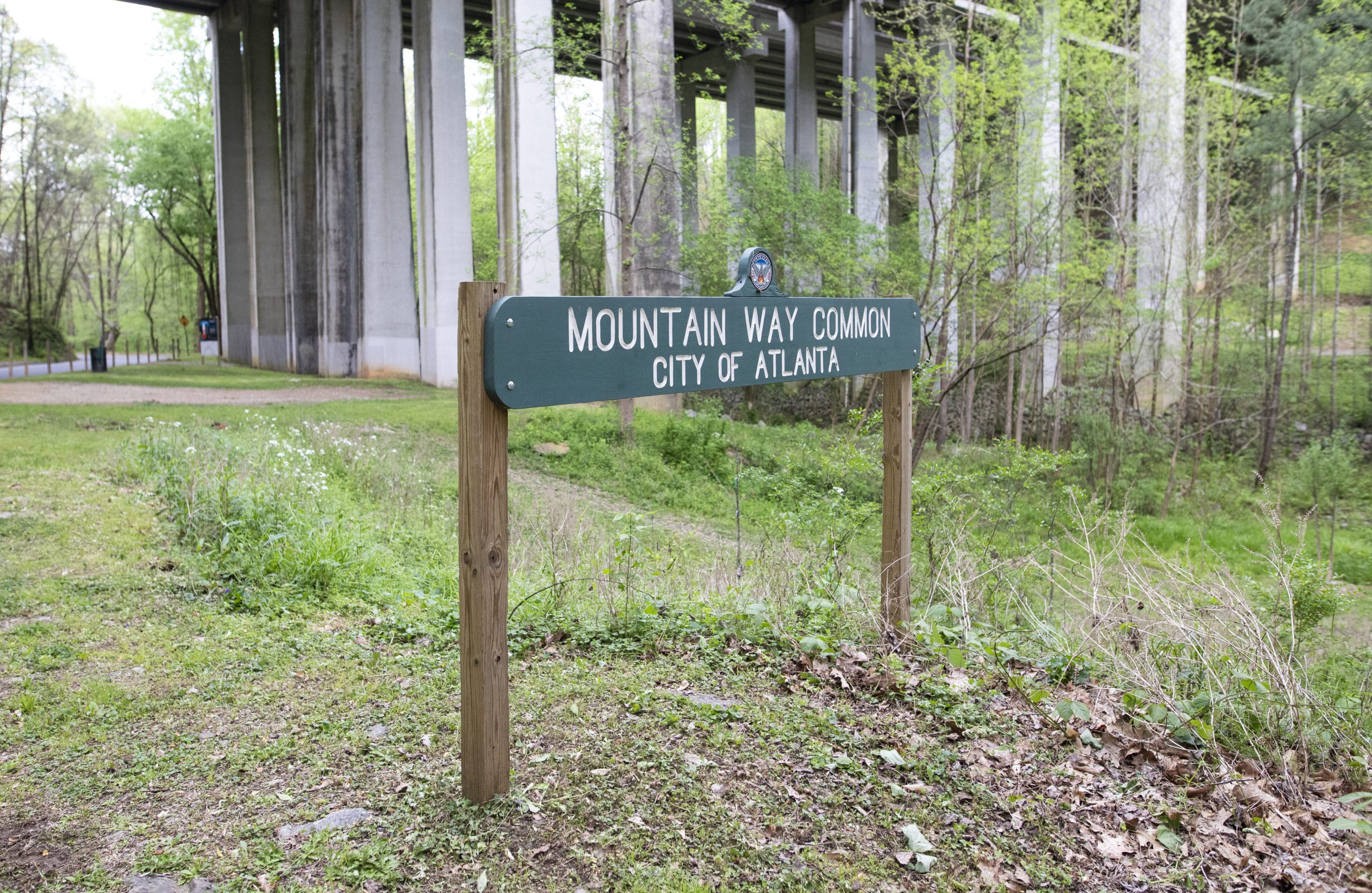

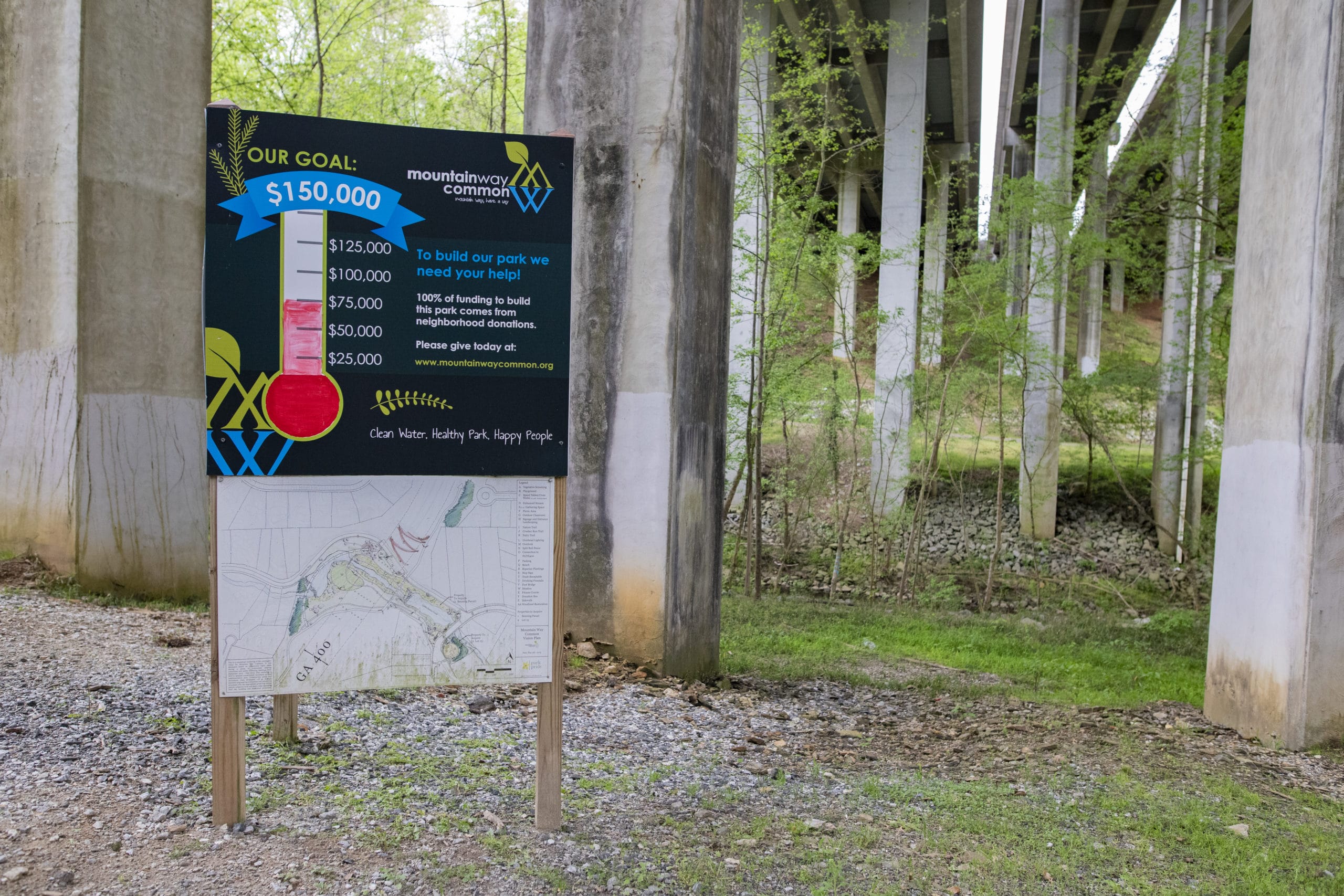
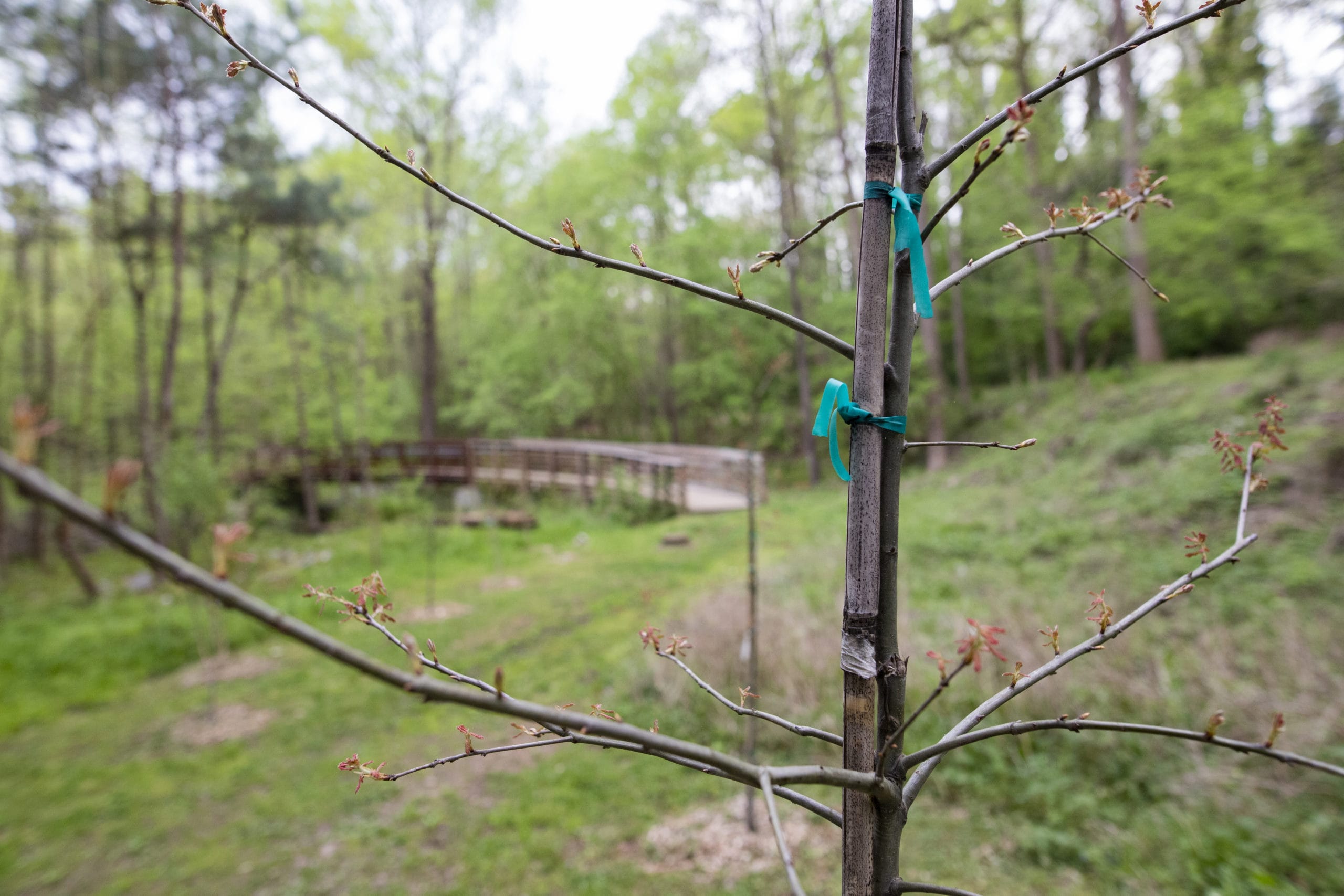
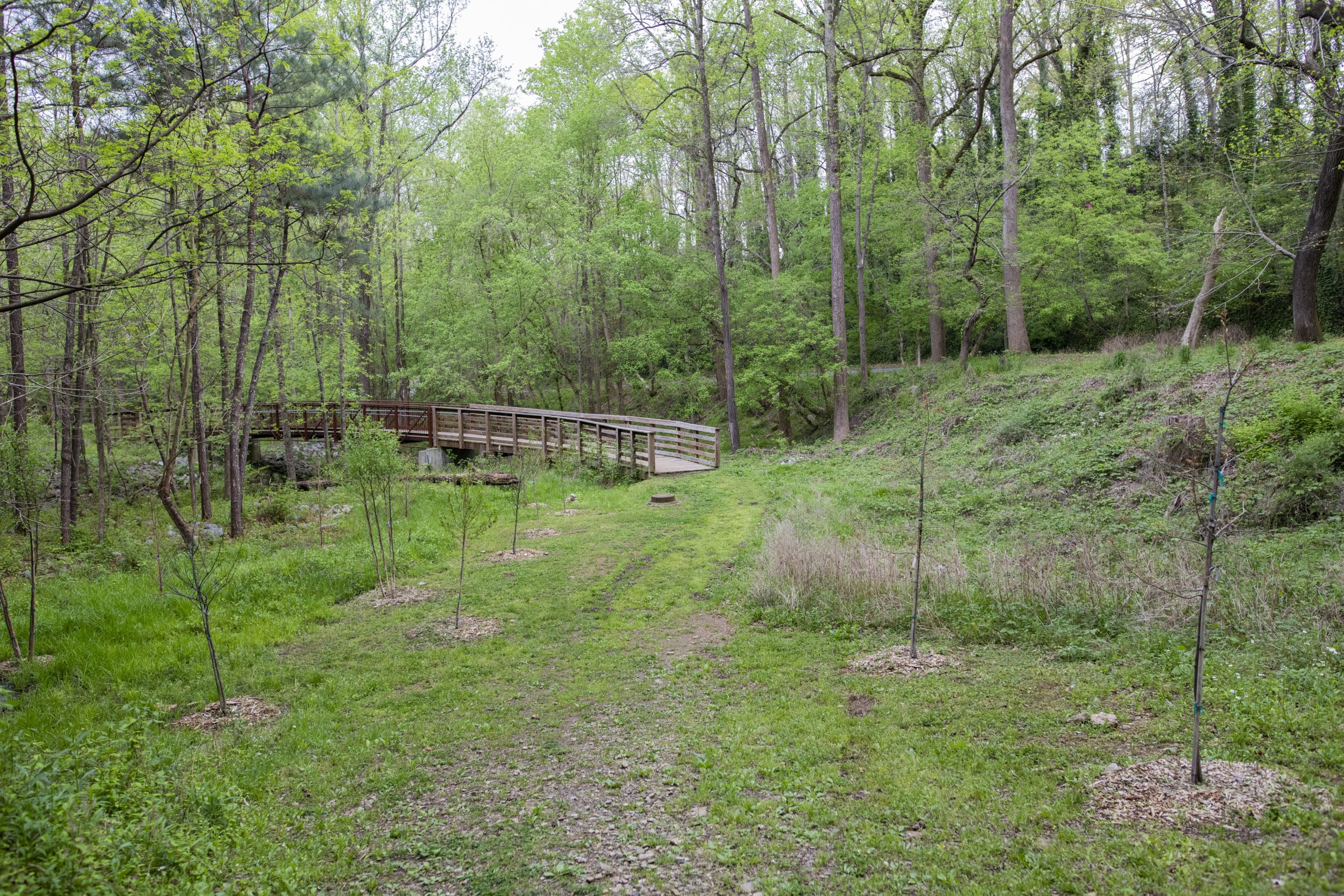
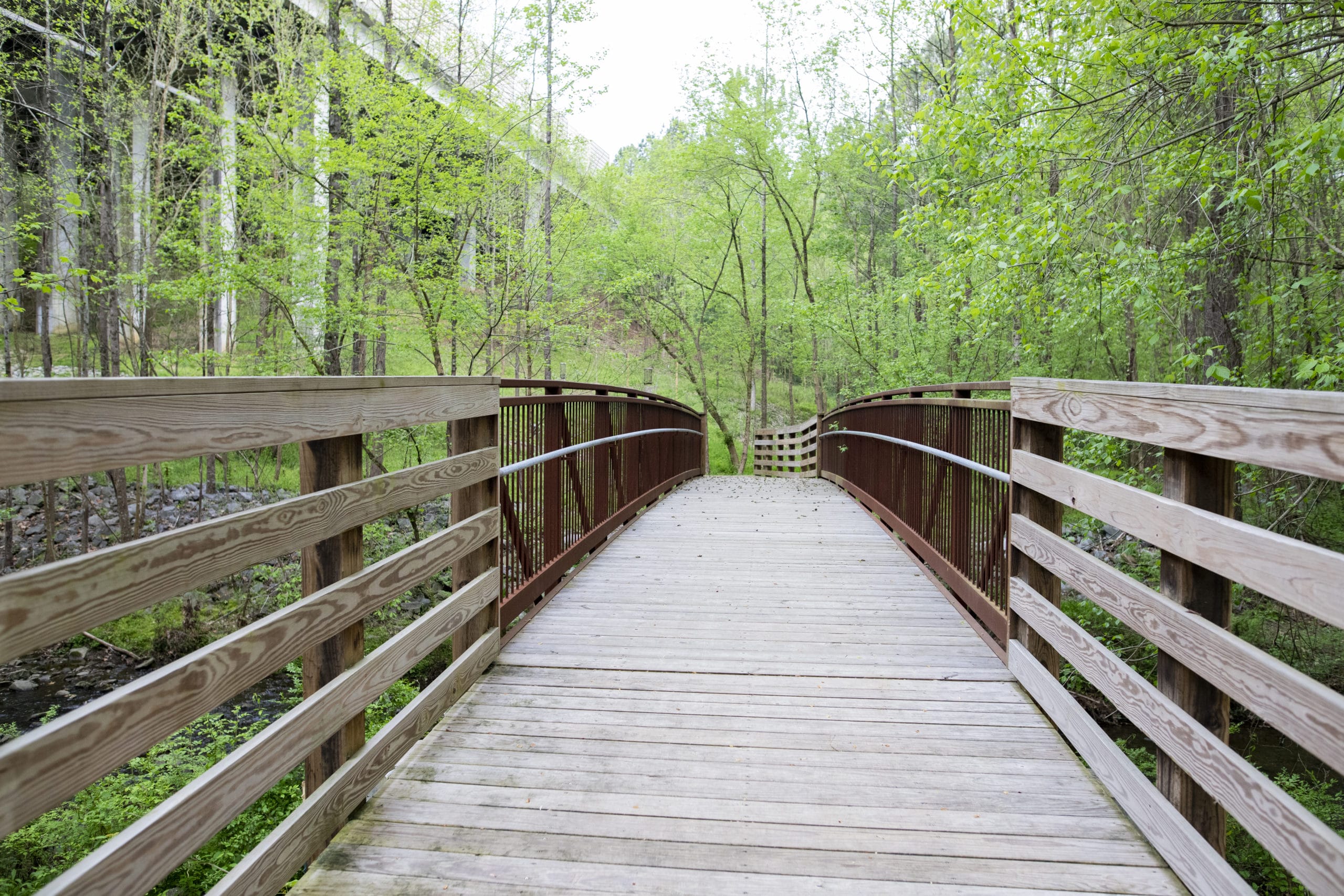
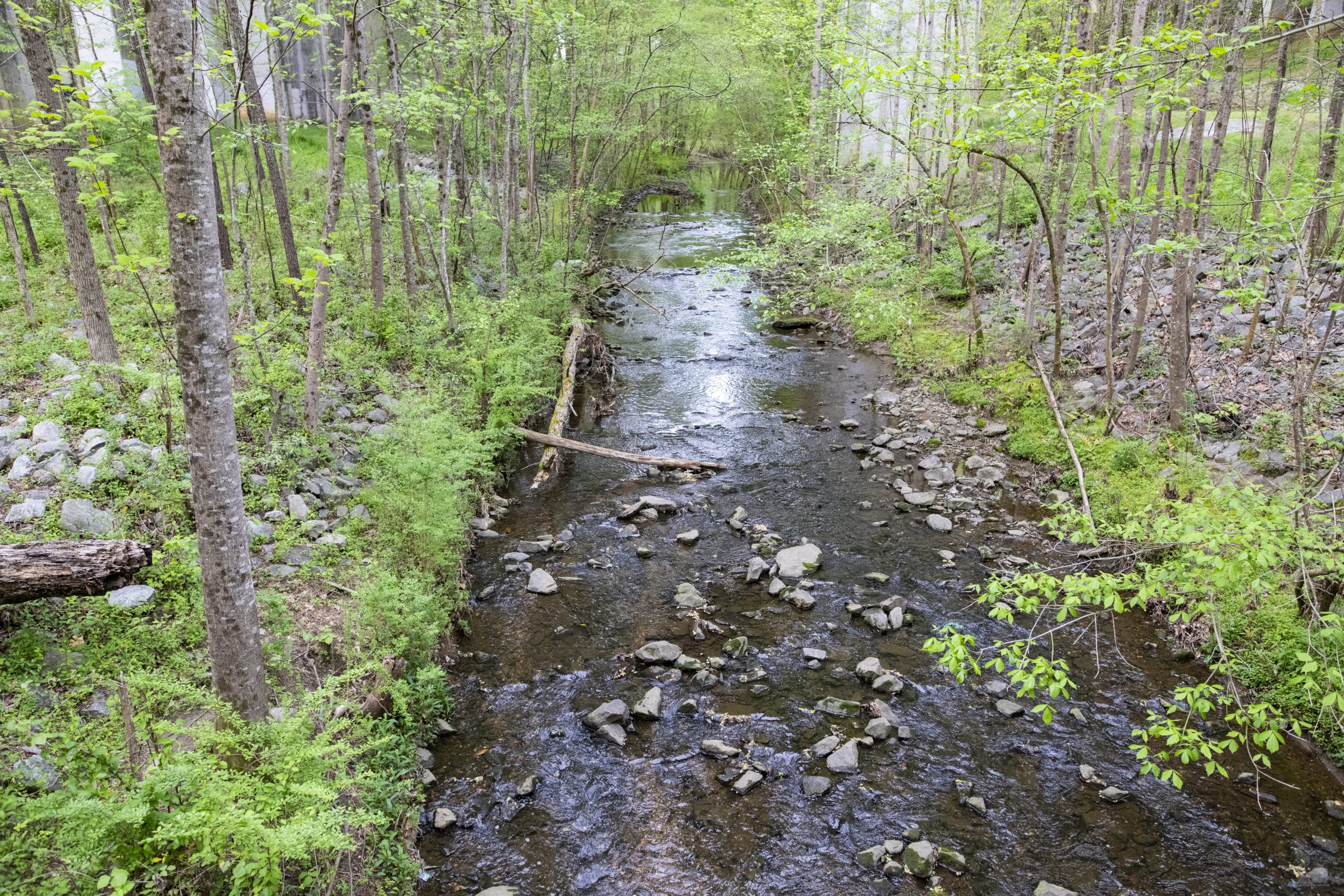
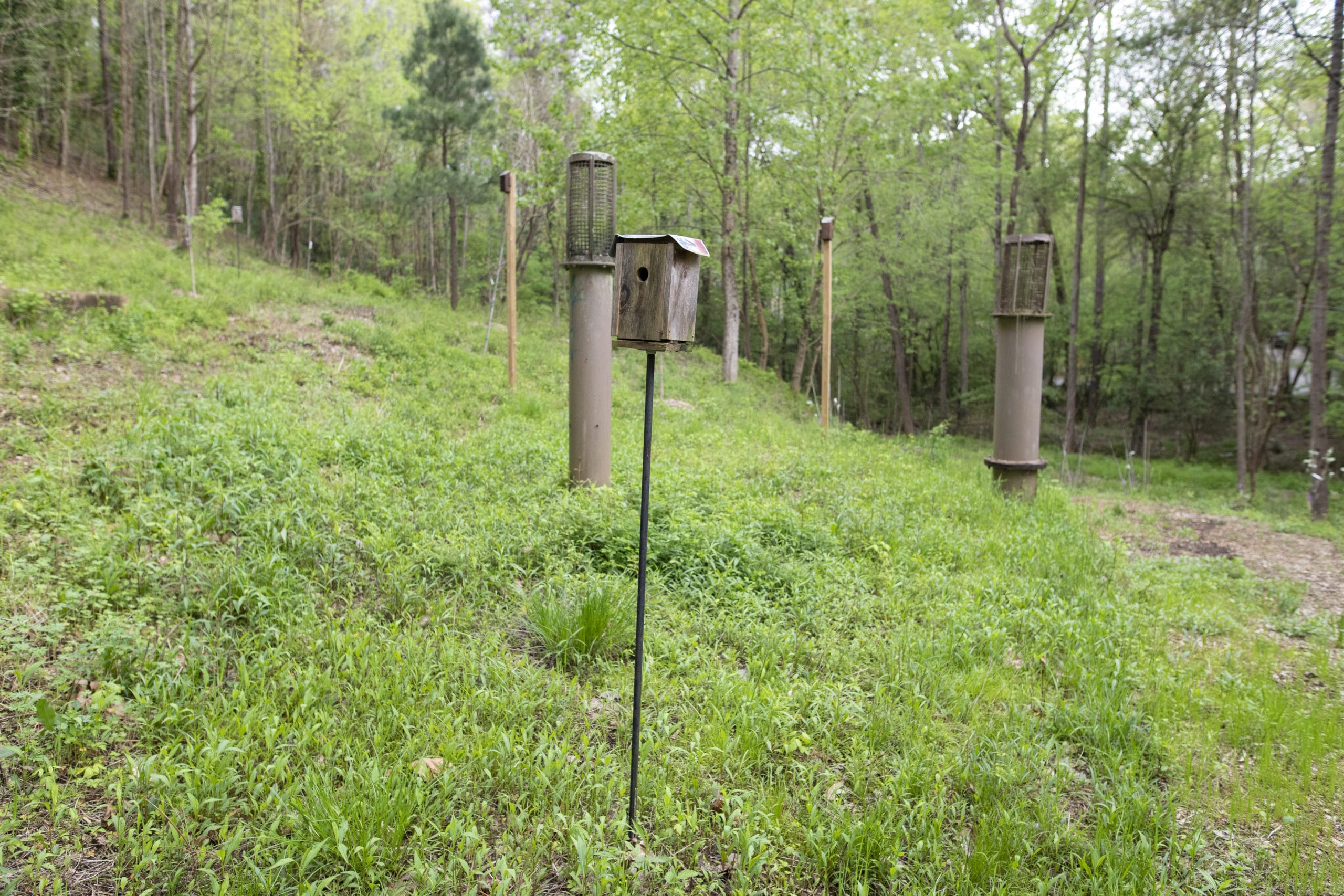

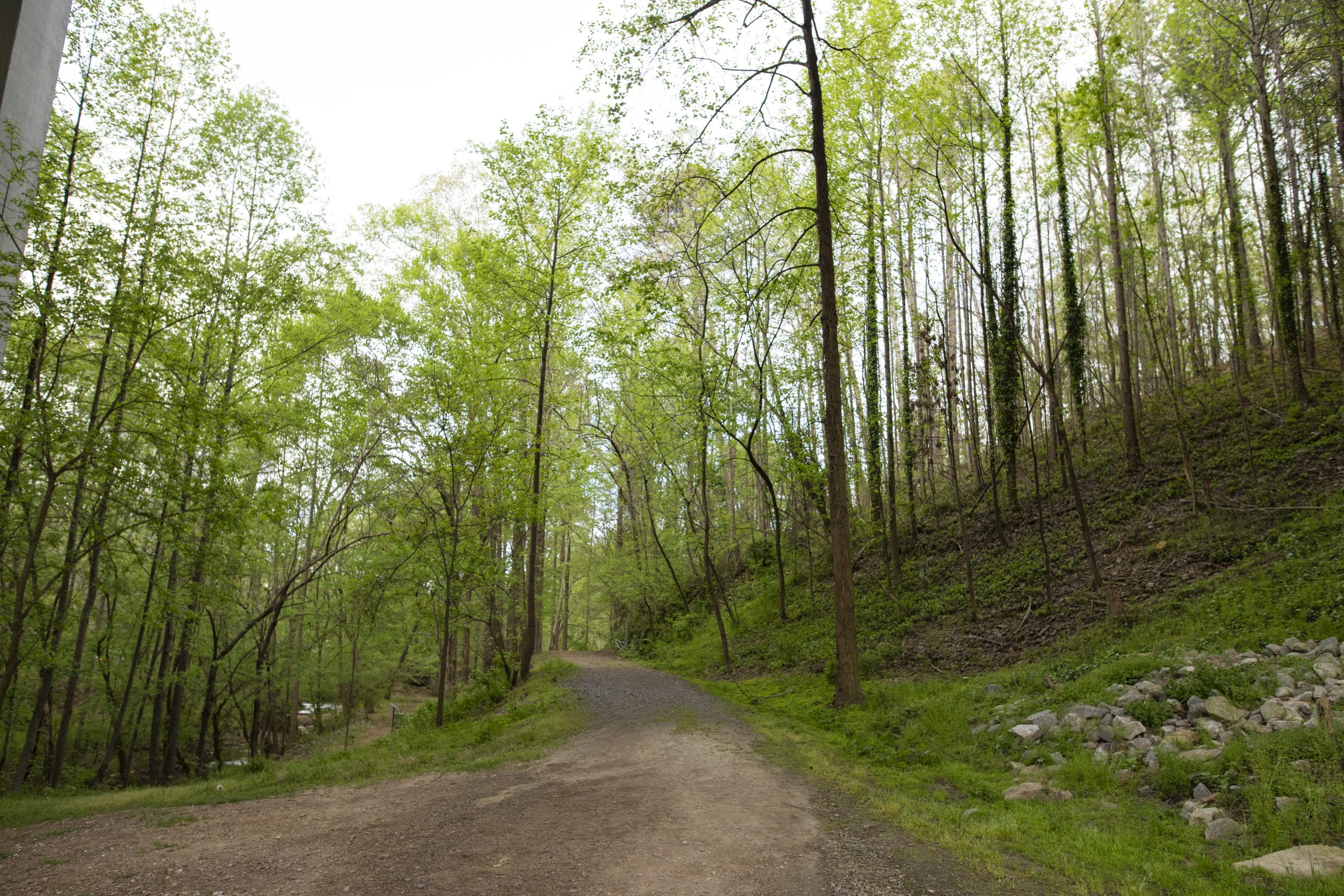
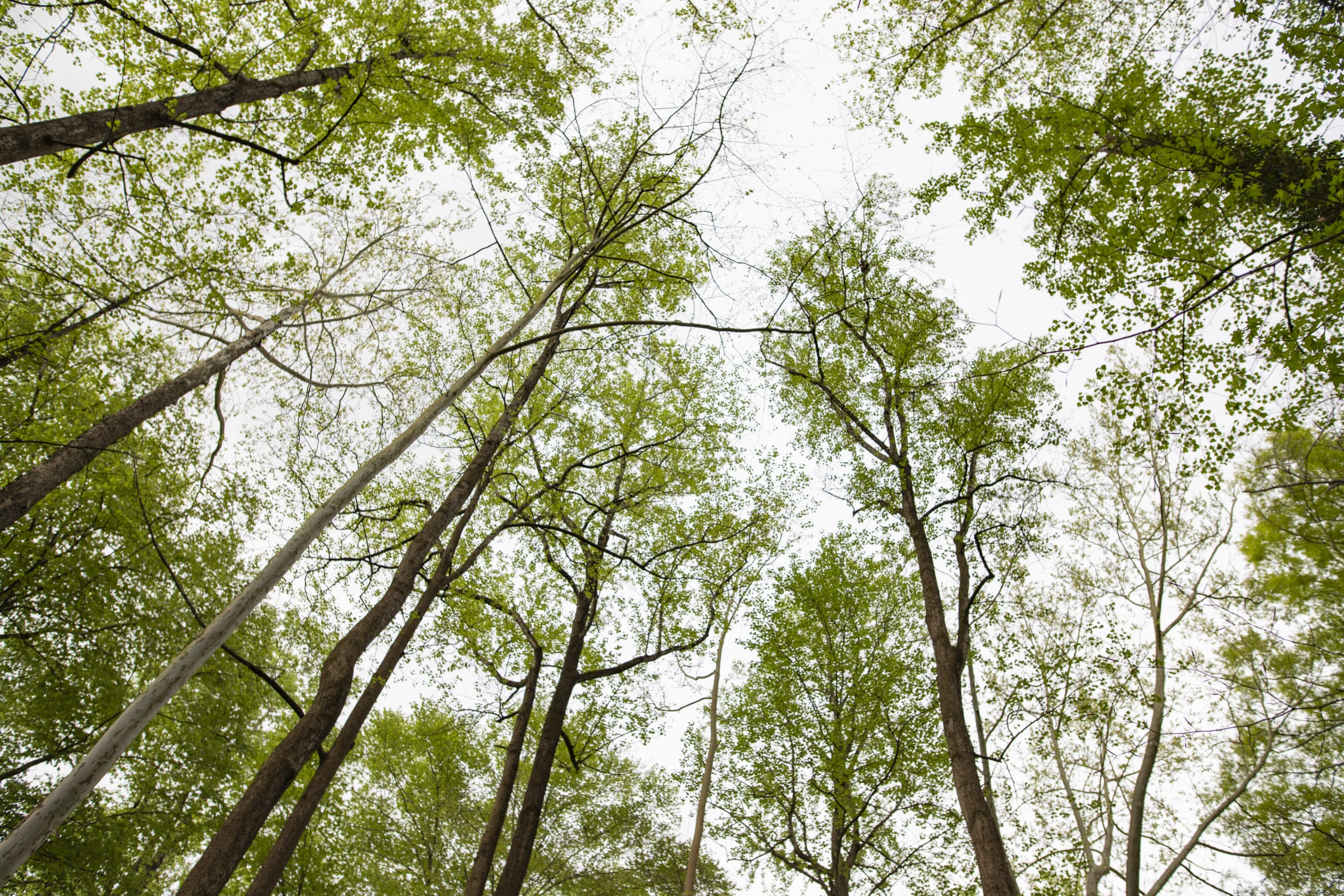
Under a grey sky, clouds swollen with rain, I found myself in a creekside park looking up at the underside of GA-400. Cars zoom overhead, punctuated occasionally by the rumble of a semi as it crossed over the cement overpass that spans Little Nancy Creek and Mountain Way Park. The stark contrast of the monumental structure against the wildness of the park’s meandering trails provides a compelling juxtaposition. Little Nancy Creek is a perennial waterway originating from Nancy Creek and winds through the North Buckhead neighborhood, splitting off to meet the Brookhaven Country Club Lake to the east and ending just beyond Peachtree Dunwoody Road in the south.
A number of young saplings are planted beside the path which leads to a footbridge that crosses the creek. Birdhouses on posts dot the landscape between tall, hollow cylinders that act as ventilation for the Atlanta Combined Sewage Overflow Nancy Creek Tunnel that runs under the property. A few lovingly cared-for planters are located at the north end of the park and bright red park benches can be found at scenic spots along the creek’s edge. Old growth trees dominate the park’s northern half while the southern portion is populated by younger trees, not yet providing a canopy to the fresh trails underneath.
Mountain Way Common wasn’t always a park. In 1990 when construction of GA-400 and MARTA cut a track through heavily forested neighborhoods in North Buckhead, this site served as a staging ground of construction materials for the roughly 100’ tall overpass overhead. Later, the city of Atlanta used the area as an access point for the sewage system that was run under the property and is the reason for those tall cylindrical vents. The land was not tended by the City and became a harsh tangle of invasive species that were so overgrown the area was inaccessible. Everything changed when a jogger was violently attacked by someone hiding in the bush, a shocking act that prompted the community to bind together and take measures to clean up the park.
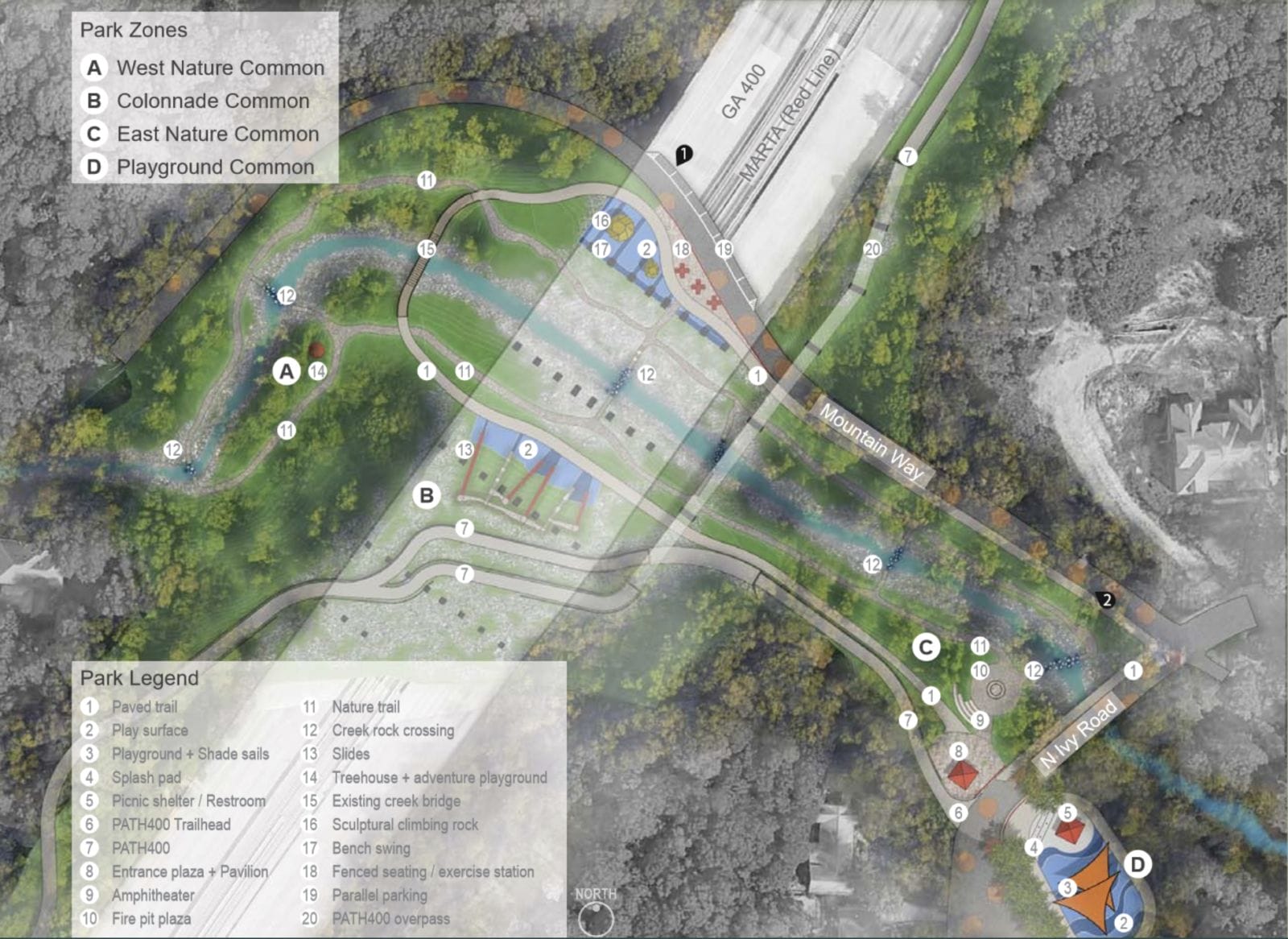
Grassroots efforts to consolidate land began in 2008, and since then the park has earned a Legacy Grant from Park Pride, a Kendala Fund Grant, and Waterfall Foundation Grant. The master plan includes paved trails, splashpad, playground, treehouse, climbing rock, swing, picnic shelter, fire pit, amphitheater, restrooms, and Path400 trailhead. Most recently the park was awarded a Trees Atlanta Neighborwoods Grant and National Environmental Education Foundation Grant to plant the Hornaday Forest thanks to the efforts of one dedicated young man, Matthew Keagle.
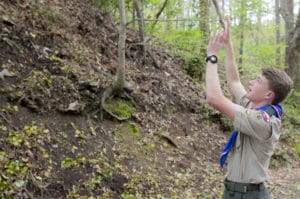
Keagle is a high school junior at Holy Innocents’ Episcopal School and an Eagle Scout with Troop 370. He has been in the Scouts since he was in 2nd grade when he joined the Cub Scouts, and has dedicated 1300 hours of service to tending Mountain Way Common. Of those, 300 hours were personal and the other 1000 were completed as part of his Eagle Project and Hornaday Initiatives. Keagle first volunteered at the park during a workday when he was only 8 years old. In 8th grade he led his first cleanup effort there with about 50 Georgia Tech fraternity brothers, a team of neighbors, and Boy Scouts.
“It was interesting leading with that age gap when I was really young,” said Keagle, who had help from Park Pride in coordinating the effort. “I think that workday really taught me a lot about leadership more than anything else just because it really forced me to get out of my comfort zone.”
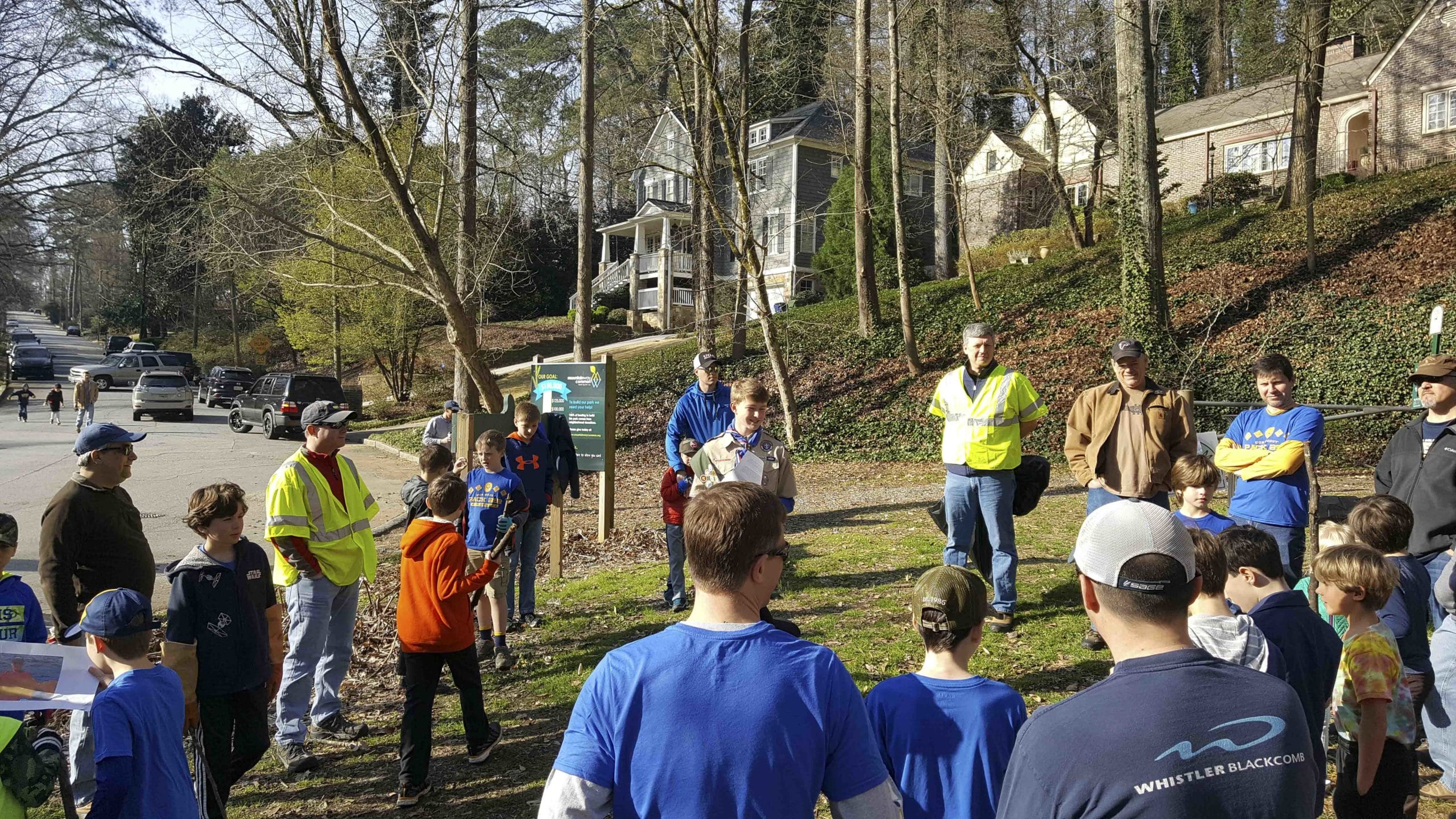
He has partnered with a number of local organizations including Livable Buckhead, Trees Atlanta who provided $9000 towards new saplings for the site in 2018, renting tools and gear from Atlanta Community Toolbank, and collecting samples for water testing with Georgia Adopt-A-Stream. “I got certified in chemical monitoring and bacterial monitoring,” he said, explaining his theory about why the creek’s E.coli levels are elevated in the summer, “what I think is the culprit for that is probably Canadian geese and golf course fertilizers. That’s been a pretty cool thing to figure out.”
The work itself is strenuous, tedious, and challenging especially during bad weather and warmer months when the bugs return in full force. The area was once packed full of invasive species of plants that are difficult to remove without chemicals that could pollute the waters of Little Nancy Creek.
“My least favorite thing was probably dealing with the invasive species. It’s really important to deal with them because they will just spread like crazy, so you have to pull them. The annoying thing is they will grow back very soon after you’ve pulled them and you’re just thinking, how does this happen? But the whole reason why they are invasive is because they can survive a lot of different things, privet especially. You have to pull privet by the roots and you have to keep on pulling it over and over and over again, and eventually it just gets weakened enough. That’s the most difficult thing.”
Keagle was initially inspired to work at Mountain Way Common because of his appreciation for playing outdoors, and when he was a child his home was just down the street from the park. He saw the property as a sort of blank slate where his Scouts work could really make a significant difference. Since the park has been restored wildlife has gradually returned to the area, and Keagle says he has seen turtles, snakes, frogs, blue herons, and even a spot along one trail where a deer slept for a period of time. Neighbors in one of the most greenspace-deprived sections of Buckhead frequent the park’s benches, trails, and a Little Free Library at the Ivy Road entrance.
While Keagle isn’t sure what his plans are after he graduates from high school next year, he says he hopes to incorporate environmental science into his life either as a minor or through ongoing volunteer effort.
“It is really rewarding when you look back and realize, man I really changed this area. That’s what I like about it, I’m going to try to keep doing that in the future.”
In days of old, in a time before video games or the internet, a strange phenomenon existed. Lost now to the passage of time it was known simply as “backyard sports.” Now this is not what you see on the well-marked playing fields of today. This was a time before uniforms, before coaches, and yes, even before parents lined the sidelines screaming for little Johnny to knock the crap out of some other 7-year-old. No leagues, no playoffs, no trophies, and thank God, no end of season award banquets. What I am talking about is sandlot baseball, backyard badminton, and hide-n-seek which we would play until darkness fell and the fireflies came out. Then parents all over the neighborhood would start screaming for the kids to come home and we would, out of breath and all sweaty.
Now I must confess I am guilty of playing on several of the organized Buckhead teams back in the day. There was no way I could call myself an athlete but I somehow managed to convince Coach Portis I should be on his Post 140 Little League baseball team with James Gibson and Joey Carone. I also played a year on the Pop Warner football team, the Colts. During scrimmage Marvin Jackson would usually mop up the field with me. I started faking injuries so I wouldn’t have to dress out. Organized sports were not for me, but boy did I love backyard sports. It didn’t matter whether it was wiffle ball with Bob Barnwell on North Stratford or basketball in Jack Pritchard’s backyard on Wieuca Road, it was all the same to me.
When I was in 7th grade my family moved from Wieuca Terrace to Millbrook Drive over near Chastain Park. It was there I experienced perhaps the highwater mark of backyard sports and the ultimate street athlete I ever encountered, Bruce Hampton. Now later Bruce would receive acclaim as a dada musician and become revered as a Living Art Object. He was indescribable, and we were blessed that he walked the streets of Buckhead and brought color to this tired and pale planet. If you don’t believe me then google his name. But, all that was much later. The time I speak of was before he ever picked up that first guitar.
Living near him in the 1960s I was able to witness many of his exploits in this domain. Whether he was physically involved or just diving deeply into the history, strategy, or statistics of any sport, Bruce was 100% there. Didn’t see him do too much with tennis or swimming but everything else was up for grabs. Football, basketball, baseball, and golf down at Chastain Park were among his favorites. On a regular basis he would slaughter me in ping pong on a table in my parent’s basement. He claimed he had perfected a spin that would go clockwise as the ball approached the net, then reverse the spin to counter-clockwise before it bounced on my side. We had a regulation shuffleboard court in our backyard and Bruce was able to adapt the ping-pong double reverse spin to that sport.
When he would get bored he would invent a new sport. Bruce’s little brother, Jimmy (AKA “Face”) was younger and smaller than us, so Bruce modified football to something he called Trodderball. Not too sure where that name came from. Anyway, the rule that was everyone but Jimmy played on their knees. Try running up a hill on your knees a few times and tell me what that feels like.
Bruce could be a player, a manager or a coach. Once I saw him become all three. It was the summer of 1964 or ‘65 and everyone in the neighborhood was bored silly. We had read all the available comics, drank up all the Kool-Aid, and were reduced to hanging around in the woods trying to avoid our parents. Suddenly Bruce appeared on the scene with news that jarred us out of our summer doldrums. He claimed he had been at the Pot o’ Gold, the neighborhood convenience store at the corner of Roswell and Powers Ferry, and had been insulted by some kids from a nearby street. Now this was in the days when street loyalty meant something. It may not mean anything now but back then everyone was loyal to their street. There were the kids from Statewood, the ones from Lake Forrest, and we were the ones from Millbrook. You could have friends on another street, but the DNA was just a little bit different. You get the picture.
Well, Bruce said the kids from East Conway had flat out, and to his face, told him that our group the Millbrook boys were just a bunch of “pantywaists.” We didn’t know what that meant but it hinted at congenital cowardice or something perhaps even far worse. They had crossed the line of civility and had simply gone too far. The honor of Millbrook had been besmirched. A cry for vengeance rang through the air. Nothing short of spilt blood could right the wrong that had fallen upon our shoulders. A challenge must be immediately issued. A delayed or half-hearted response could impact our reputation. The word would quickly spread to other Buckhead neighborhoods that we had not risen to the challenge.
Within minutes a plan was hatched. We would challenge those teenage gangsters on East Conway to a football game. Street versus street. A clash of Titans. This would not be flag or touch football but full out tackle. No pantywaists we. Our banner of honor would once more fly freely. By unanimous consent Bruce was chosen to deliver the challenge. Before the sun set he had thrown down the gauntlet to one of the toughs on East Conway and it had been accepted. Two weeks hence, a whistle would blow, a coin would toss, and the struggle would commence. There was only one problem. We didn’t have a football team.
Of course, Bruce assumed the role of manager, coach, and trainer. In one uncharacteristic gesture of generosity he agreed to share the quarterback duties with my older brother, Steve. Drills began early the next morning to get us in shape. Bruce concocted some weird shoes that had trailing jump ropes that were tied to cement blocks. He assured us that if we wore these contraptions for only an hour a day we would “fly like the wind” on game day.
“From pain would come pleasure,” according to Bruce. After several days of intense training he suddenly disappeared into his bedroom only to emerge the next day with a sheaf of papers. These dog-eared and voluminous documents contained a series of what appeared to be a mish-mash of unrelated random lines, dashes, and squiggles. With great fanfare Bruce announced that these were the plays we would employ against our East Conway enemies. I must correct one thing at this point. While all members of our team constantly cursed the opposing team with great vulgarity and general nastiness, Bruce did not participate in this activity which he felt demonstrated a certain coarseness of character. He took the high road and when he needed to mention our opposition he would refer to them only as “those people.”
My parent’s basement wall became Bruce’s blackboard when he announced the time had arrived for a “chalk talk.” I was not aware of what that meant but I soon found out. He requested the shades to be closed and only then did he begin to reveal the plays and our various assignments. Under the artistry of Bruce’s black magic marker, the wall was soon covered with an intricate chicken scratch of planning. I now know that some of the plays we were shown had been outlawed back in the 1930s and others were almost impossible to execute even if we knew what we were doing, which we didn’t.
There was the “Flying Vee,” the “Flea Flicker,” and the infamous “Wedge to Nowhere.” Some of the plays were designed to create psychological distress in an opponent and some bordered on the non-rational. Bruce had it all covered. He knew we were outmatched on a man to man basis and only a transcendental strategy could carry the day. Hour after hour Bruce instructed us in the details of what we should do, when to do it and the delicate nuances of how not a “fake out” but a “fake in” could fool any opponent. One minute he would berate us for a lack of comprehension of what he called the “grand plan” and the next minute he would be building us up saying we were champions who would go down in street history. We were putty in his hands. The pitch of his voice gradually grew higher and higher, veins started popping out on his neck, and his face turned beet red. I wasn’t sure how long this fevered sermon could last when, with one last gasp of energy, Bruce exclaimed, “Every play is designed to score.”
The natural talent on our team was almost non-existent but Bruce developed a plan to take maximum advantage of what we did have. He and Steve would alternate as quarterback. All offensive plays would be run from the shotgun formation. Bruce claimed that gave him a split-second advantage to search downfield for a receiver. We did have two receivers. One was Bruce’s little brother, “Face.” Face was much younger than any of us but was very quick and only about 4 feet tall. The other receiver was my cousin Tommy Shaw who topped out at 6’ 6”. He was tall and skinny. Bruce’s plan was to have Face and Tommy run to the same area of the field and have Face stand in front of Tommy. From a functional point of view, he had created a receiver with 4 hands. It was like having an octopus downfield with 4 tentacles. He would then launch the ball in that general direction and chances were it would be caught. “A vertical flooding of the zone,” Bruce called it.
For a defensive strategy Bruce devised one simple plan. This involved a bit of deception, but we were assured that “sometimes you have to do what you have to do.” Bruce wanted John Durham on our team but there was one problem. John did not live on Millbrook, so he was technically ineligible. However, as Bruce told us, since John could stand in his side yard on a neighboring street and crane his neck, he could see our street. That was good enough for us and Bruce built the defense around John. I don’t know much about the private instructions John received but here is what I saw.
Bruce told John he had to play barefoot. Don’t ask me why. Bruce would not use John’s name but only referred to him as “Monster Man.” Don’t ask me why. John played as a defensive back and received some type of coded instruction from Bruce just an instant before the other team hiked the ball. It was some form of non-verbal communication I never understood but the outcome would be “Monster Man” either running directly toward the ball carrier or directly AWAY from the ball carrier. In addition, John was to emit the terrifying sound of the Rebel Yell as he ran careened barefoot across the field. Now is not the time for a full discourse of the actual sound of the Rebel Yell, nor the impact on those who heard it, but it was a sound that one could imagine came when the banshees of hell were let loose to bring havoc on this gentle earth. This was a scary thing to witness, even for those on our team.
As Game Day approached Bruce decided it was time for a live scrimmage with full uniforms. We had mismatched helmets, jerseys, and pads. Some of us wore tennis shoes. Bruce was outfitted with a motorcycle jacket in which he stuffed towels, was wearing bowling shoes and he topped it all off with a baseball catcher’s mask. I was adorned with my father’s golf shoes and 3 layers of winter coats. We were instructed to present ourselves at the lower field at the nearest school, Dykes High School, for the “full contact” practice. Bruce had maintained relationships with some of the Dykes players who were now playing football on the Junior Varsity at Georgia Tech. He had somehow convinced them to show up and play against us. I’m pretty sure he had told them it was some sort of charity event which it wasn’t. They had that figured out in about 10 seconds but since they all knew Bruce there were no hard feelings.
Those guys were totally unprepared for what we threw at them. They expected some type of competition based on traditional logic and rational expectation. They could not adapt to the concept of our double receiver concept which basically was like having one player with four hands catching Bruce’s passes. The frightful image of a barefoot Monster Man shrieking a Rebel Yell while running away from the ball was just too unnerving. After only 15 minutes Bruce called it quits before any of us got hurt. He had seen enough to know that we were indeed ready.
The game was set for noon, High Noon as they say in the deserts of the West. We were calm and ready. Mounting our bikes, we rode down the long hill to the field at Chastain Park, arriving early. We were totally prepared. Hell, if we had another week we could have organized a cheering squad with a few pom-pom girls. Noon arrived, then 12:15. By 12:30 we still had not seen the whites of their cowardly eyes. Something was amiss. Perhaps they were simply too afraid to show. Had word reached East Conway at the way we had dispatched the college boys?
Finally, we sent Tommy down to their hangout, escorted by Pete Terrell and Face. Always good to have a little back up in case trouble should arise. They were back in ten minutes with the news. Those no-good kids from East Conway were not coming. In fact, they never had any intention of coming. They were just a bunch of loose lips shooting off their mouths at the Pot o’ Gold. All talk and no substance.
We were furious.
There was much muttering and spitting on the ground. My brother channeled his anger by hammering my shoulder with his rendition of the deadly “knuckle sandwich.” Only Bruce remained calm amidst the chaos and fury.
“Boys,” he said, “let not your hearts be fiery. You have shown strong intention and that brings honor to Millbrook. We can lift our heads high.”
We rode our bikes home in silence, and you better believe we took the long way home. The way that took us down East Conway. We pedaled slow down that road with more than a little pride. The Millbrook Marauders never played a game, but never lost. Unvarnished, our reputation would go down in the history book of our street. All hail Millbrook Drive, the home of the only Buckhead team to never know defeat.

Jim Tate
Author, Buckhead Tales
jimtate@charter.net